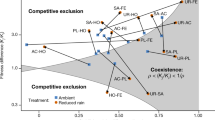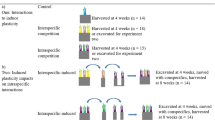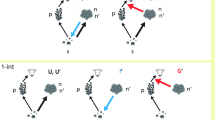Abstract
Plants can have positive effects on each other1. For example, the accumulation of nutrients, provision of shade, amelioration of disturbance, or protection from herbivores by some species can enhance the performance of neighbouring species. Thus the notion that the distributions and abundances of plant species are independent of other species may be inadequate as a theoretical underpinning for understanding species coexistence and diversity2. But there have been no large-scale experiments designed to examine the generality of positive interactions in plant communities and their importance relative to competition. Here we show that the biomass, growth and reproduction of alpine plant species are higher when other plants are nearby. In an experiment conducted in subalpine and alpine plant communities with 115 species in 11 different mountain ranges, we find that competition generally, but not exclusively, dominates interactions at lower elevations where conditions are less physically stressful. In contrast, at high elevations where abiotic stress is high the interactions among plants are predominantly positive. Furthermore, across all high and low sites positive interactions are more important at sites with low temperatures in the early summer, but competition prevails at warmer sites.
This is a preview of subscription content, access via your institution
Access options
Subscribe to this journal
Receive 51 print issues and online access
$199.00 per year
only $3.90 per issue
Buy this article
- Purchase on Springer Link
- Instant access to full article PDF
Prices may be subject to local taxes which are calculated during checkout




Similar content being viewed by others
References
Callaway, R. M. Positive interactions among plants. Bot. Rev. 61, 306–349 (1995)
Callaway, R. M. Positive interactions in plant communities and the individualistic-continuum concept. Oecologia 112, 143–149 (1997)
Berlow, E. L. Strong effects of weak interactions in ecological communities. Nature 398, 330–334 (1999)
Miller, T. E. Direct and indirect species interactions in an early old-field plant community. Am. Nat. 143, 1007–1025 (1994)
Grime, J. P. Evidence for the existence of three primary strategies in plants and its relevance to ecological and evolutionary theory. Am. Nat. 111, 1169–1194 (1977)
Connell, J. H. On the prevalence and relative importance of interspecific competition: evidence from field experiments. Am. Nat. 122, 661–696 (1983)
Pugnaire, F. I. & Luque, M. T. Changes in plant interactions along a gradient of environmental stress. Oikos 93, 42–49 (2000)
Brooker, R. W. & Callaghan, T. V. The balance between positive and negative plant interactions and its relationship to environmental gradients: a model. Oikos 81, 196–207 (1998)
Bertness, M. D. & Callaway, R. M. Positive interactions in communities. Trends Ecol. Evol. 9, 191–193 (1995)
Markham, J. H. & Chanway, C. P. Measuring plant neighbor effects. Funct. Ecol. 10, 548–549 (1996)
Grime, J. P. Plant Strategies and Vegetation Processes (Wiley, Chichester, 1979)
Dodds, W. K. Interspecific interactions: constructing a general neutral model for interaction type. Oikos 78, 377–383 (1997)
Woodward, F. I., Smith, T. M. & Emanuel, W. R. A global primary productivity and phytogeography model. Glob. Biogeochem. Cycles 9, 471–490 (1995)
Shaver, G. R. & Jonasson, S. Response of arctic ecosystems to climate change: result of long-term field experiments in Sweden and Alaska. Polar Res. 18, 245–256 (1999)
Prentice, C. I. et al. A global biome model based on plant physiology and dominance, soil properties, and climate. J. Biogeogr. 19, 117–134 (1992)
Gleason, H. A. The individualist concept of the plant association. Bull. Torrey Bot. Club 53, 7–27 (1926)
Whittaker, R. H. Communities and Ecosystems (Macmillan, New York, 1975)
Begon, M., Harper, J. L. & Townsend, C. R. Ecology 2nd edn 626–628 (Blackwell, London, 1990)
Johnson, H. B. & Mayeux, H. S. Viewpoint: a view on species additions and deletions and the balance of nature. J. Range Manag. 45, 322–333 (1992)
Curtis, J. T. The Vegetation of Wisconsin (Univ. Wisconsin Press, Madison, 1959)
Whittaker, R. H. A consideration of climax theory: the climax as population and pattern. Ecol. Monogr. 23, 41–78 (1953)
Austin, M. P. Continuum concept, ordination methods, and niche theory. Annu. Rev. Ecol. Syst. 16, 39–61 (1985)
Callaway, R. M. Are positive interactions species-specific? Oikos 82, 202–209 (1998)
Choler, P., Michalet, R. & Callaway, R. M. Facilitation and competition on gradients in alpine plant communities. Ecology 82, 3295–3308 (2001)
Archibold, O. W. Ecology of World Vegetation 280–318 (Chapman and Hall, London, 1995)
JMPin 4.0.2 (SAS Institute Inc., Duxbury Press, Cary, North Carolina, 2000)
Acknowledgements
We thank the National Center for Ecological Synthesis and Analysis, The National Geographic Society, the Civilian Research and Development Foundation, and the Andrew W. Mellon Foundation for financial support.
Author information
Authors and Affiliations
Corresponding author
Ethics declarations
Competing interests
The authors declare that they have no competing financial interests.
Supplementary information
Rights and permissions
About this article
Cite this article
Callaway, R., Brooker, R., Choler, P. et al. Positive interactions among alpine plants increase with stress. Nature 417, 844–848 (2002). https://doi.org/10.1038/nature00812
Received:
Accepted:
Issue Date:
DOI: https://doi.org/10.1038/nature00812
This article is cited by
-
Facilitation and competition deconstructed: a mechanistic modelling approach to the stress gradient hypothesis applied to drylands
Scientific Reports (2024)
-
Reciprocal facilitation between ants and small mammals in tidal marshes
Oecologia (2024)
-
The effects of nucleation and species functional traits on tree seedling performance in the early stage of ecological restoration
Plant Ecology (2024)
-
Seed germination and seedling growth response of Leymus chinensis to the allelopathic influence of grassland plants
Oecologia (2024)
-
The importance of species addition ‘versus’ replacement varies over succession in plant communities after glacier retreat
Nature Plants (2024)
Comments
By submitting a comment you agree to abide by our Terms and Community Guidelines. If you find something abusive or that does not comply with our terms or guidelines please flag it as inappropriate.



